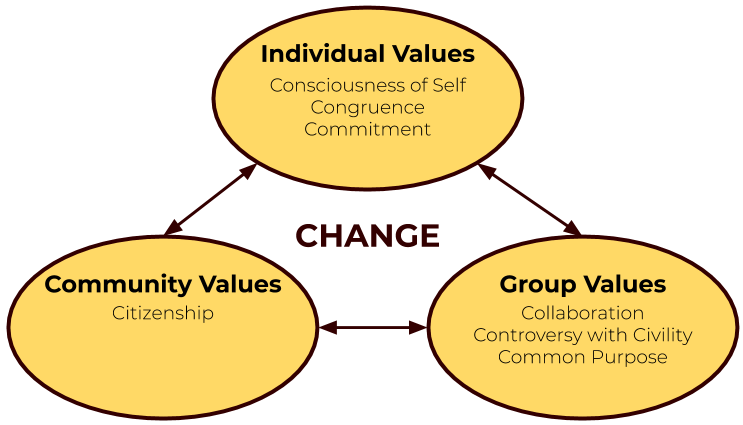The Social Change Model of Leadership
The Social Change Model of Leadership
The Social Change Model of Leadership

The Social Change Model is what underpins our campus leadership program at Rowan. This model approaches leadership as collaborative, purposeful, and based on different values that can affect positive social change.
It describes leadership as a purposeful, collaborative, values-driven process, instead of a title or position. Leaders try to improve the groups or communities they are part of. In this approach to leadership, a "leader" is anyone who wants to work with others to make a difference. This kind of collaborative process means that groups must have trust, which requires that group members act in ways that are consistent with their own beliefs and values as well as the group’s goals. The team that developed the model concluded that eight values are necessary in order to have trust, common goals and true collaboration.
The Social Change Model & our Leadership Rowan program is built upon the following assumptions:
- Leadership is socially responsible; it impacts change on behalf of others.
- Leadership is collaborative.
- Leadership is a process, not a position.
- Leadership is inclusive and accessible to all people.
- Leadership is values-based.
- Community involvement & service are important and effective vehicles for leadership.
At Leadership Rowan, we believe there is no such thing as a “natural-born leader”. Some people may be naturally charismatic, or naturally better at things like negotiating or public speaking. But leadership defined as a purposeful, collaborative process relies on skills that can be learned by all students who take the time to learn and grow.
The Social Change Model focuses on seven values spread across three dimensions of leadership. All these values contribute to the goal of positive social change.
Individual Values
Consciousness of Self — The self-awareness of the values, attitudes, and beliefs that motivate us to take action. This is the key to being able to develop consciousness of others. Students will explore their own strengths and weaknesses and how to use those qualities to operate in a changing environment.
Congruence — Thinking, feeling, and behaving with consistency, authenticity, and honesty towards yourself and others. Students will investigate how actions are or aren’t consistent with their most deeply-held beliefs and values.
Commitment — The motivation of the individual to serve and that drives the collective effort. Commitment implies passion, intensity, and duration.
Group Values
Collaboration — The quality to work with others in a common effort. Collaboration constitutes the cornerstone value of the group leadership effort because it empowers self and others through trust. Leadership as a group process & encourages the group to transcend individual goals, interests and behaviors.
Common Purpose — The quality to work with shared aims and values. Common Purpose allows students to facilitate the group’s ability to engage in collective analysis of issues at hand and the task to be undertaken. This is best achieved when all members of the group share in the vision and participate actively in articulating the purpose and goals of an activity.
Controversy with Civility — This recognizes two fundamental realities of any creative group effort: that differences in viewpoint are inevitable, and that such differences must be aired openly, but with civility. Civility implies respect for others, a willingness to hear each others’ views, and the exercise of restraint in criticizing the views and actions of others. This value requires trust amongst the group members. Conflicts do need to be resolved but also integrated into leadership development.
Community/Societal Values
Citizenship — The process in which an individual & the collaborative group become responsibly connected to the community and the society through a leadership development process. Students will explore ways to be a good citizen & to work for positive change on the behalf of others and the community. The practice of good citizenship should happen at every level of leadership development.
The Main Goal
Change — The ability to adapt to environments and situations that are constantly evolving, while maintaining the core functions of the group. Change is the value “hub” which gives meaning to the 7 C’s and is the ultimate goal of the creative process of leadership – to make a better world and a better society for self and others. The courage involved in social change is great, and the willingness to take a leap of faith toward a novel idea or a different tactic may require an acceptance of ambiguity, transition, and even discomfort. Although this is a difficult call to action, leadership requires that change (small or large scale) be attempted and, ideally, enacted.
